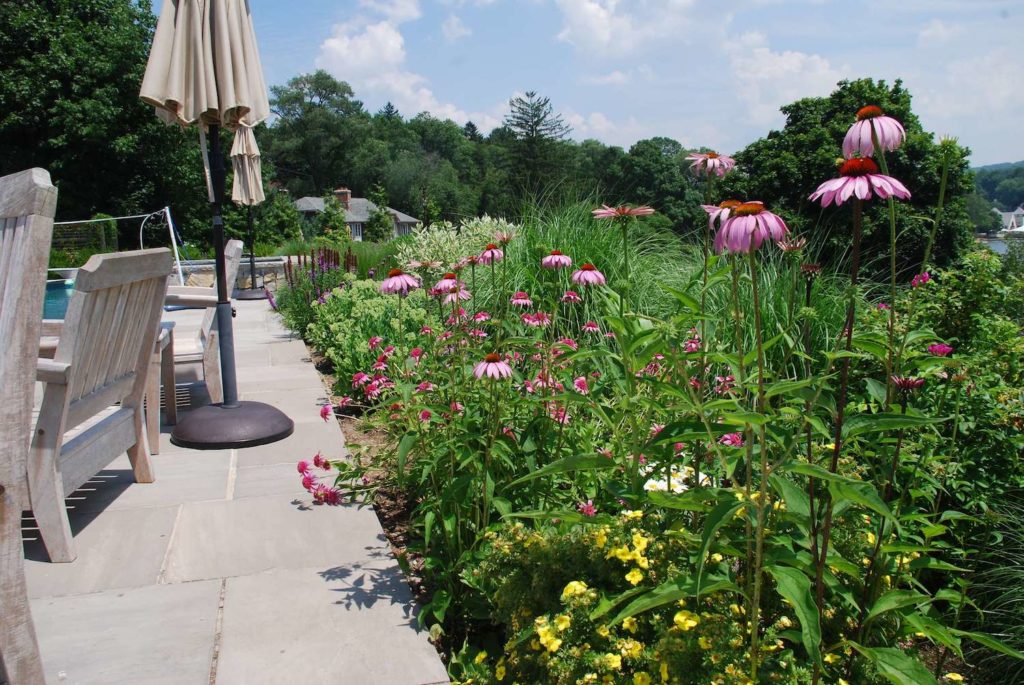We offer design consultation, construction services and management strategies which focus specifically on ecological landscape principals. Our goals are to reduce water consumption, preserve water quality, prevent soil erosion, protect biodiversity, decrease the use of toxic pesticides, and minimize the use of non-renewable resources. By striving toward these goals, we can create gardens that are both aesthetically pleasing and environmentally responsible.
Guidelines of Ecological Landscaping
With the desire to eliminate and reduce the use of pesticides, consider the water and air quality of the site, preserve biodiversity, and acknowledge the health of clients and the practitioner, the Ecological Landscaping Association is committed to educating others about environmentally sound methods of landscape design, installation, and maintenance.
The mission of ELA resounds loud and clear: The Ecological Landscaping Association advocates for environmentally responsible stewardship of land and natural resources in the landscaping and horticultural practices of professionals and the public. Through education, collaboration, and networking, ELA promotes the design, installation, and maintenance of landscapes that are guided by a knowledge of and respect for natural ecosystems.

ECOLOGICAL LANDSCAPING IS A METHOD of designing, building, and maintaining landscapes that considers the ecology of a site and creates gardens that enhance the surrounding environment for the benefit of humans and all other life in the ecosystem. When the earth is disturbed during the construction of buildings, homes, driveways, and roadways, the land is forever altered.
Although the natural landscape can never be restored completely, with thoughtful attention to the site, ecological landscapers can create outdoor spaces that are practical, healthy, and aesthetically pleasing. Ecological landscaping strives to balance the building site with the natural environment. It draws upon the wisdom of natural systems. By studying the inter-relationships between living things, non-living things, and the environment, ecological landscapers can create a landscaped community that will conserve natural resources, preserve biodiversity, and protect the environment.
With proper design and implementation, a healthy pattern begins to form with each component in the landscape; people, animals, plants, water, soil, insects, and wildlife, all interacting in a sustainable way. Conservation is an important part of ecological landscaping.The objectives of an ecological landscaper are to reduce water consumption, preserve water quality, prevent soil erosion, protect biodiversity, diminish the use of toxic pesticides, and minimize the use of non-renewable resources.
By striving toward these goals, the ecological landscaper can create gardens that are both environmentally responsible and enjoyable to experience.
“We abuse land because we regard it as a commodity belonging to us. When we see land as a community to which we belong, we may begin to use it with love and respect.” — ALDO LEOPOLD
• Selecting plants based upon an analysis of the site
• Favoring regionally propagated plants and cultivars that are disease or pest-resistant
• Amending planting areas with compost and organic matter if needed
• Planting at the correct depth trees, shrubs, perennials, and annuals
• Applying mulches to improve soil texture and retain moisture
• Keeping mulches away from tree bark or stem to prevent rotting
• Selecting plants based upon an analysis of the site
• Favoring regionally propagated plants and cultivars that are disease or pest-resistant
• Amending planting areas with compost and organic matter if needed
• Planting at the correct depth trees, shrubs, perennials, and annuals
• Applying mulches to improve soil texture and retain moisture
• Keeping mulches away from tree bark or stem to prevent rotting
Water restrictions, expensive irrigation systems, and contaminants that enter the water supply are concerns that can be alleviated through the practice of an ecological approach to landscape design. Water can be conserved and kept on site instead of running off into storm drains. Reduced consumption of water can be achieved by…
• Reducing lawn size, planting sun and shade gardens, and adding more vegetative cover
• Using native plants adapted to local conditions
• Mulching and composting to increase water retention
• Watering slowly and deeply in early morning or evening
• Using rain barrels and rain gardens to prevent run-off
• Matching plants to site conditions and grouping plants according to water needs
• Avoiding turf on steep inclines and isolated strips
• Using paving materials for hardscape areas, such as cement pavers, to allow for drainage, instead of run-off Erosion by wind and water brings sediment into streams and results in loss of nutrient-rich topsoil.
• Vegetative cover such as hedgerows and crosswind-planted strips
• Slopes planted with meadow plants, shrubs, or trees to hold soil in place
• Native grasses with deeper roots Pesticides and fertilizers used on lawns and gardens contaminate surface water through runoff into streams, rivers, and lakes.
• Minimizing or eliminating the use of pesticides
• Mowing lawns at highest height in order to shade out weeds
• Using mulching mowers to keep grass clippings on lawn and return nutrients to the soil
• Planting native plants adapted to the site
• Creating habitats to encourage natural predators such as ladybugs, birds, frogs, and lizards to control pests in the landscape rich wildlife
All animals, including humans, have four basic requirements to survive — food, shelter, water, and nesting areas for reproduction.When these are in abundance, a rich variety of life can be supported, creating a healthier, more resilient ecosystem for all of us to inhabit. Nuisance animal behavior can be avoided if we provide areas that meet their four basic needs in the outer limits of our properties. Natural habitats for wildlife can be increased by connecting patches and corridors of open land, woodlands, and streams between properties.
• Multiple heights and layers of native vegetation including vines, fruit, and nut-bearing plants
• Meadow areas that provide nesting materials and habitat
• Bird baths, streams, and ponds for water sources
• Thickets and brush piles for shelter
• Standing dead trees or snags and rotting logs for food and shelter
• Stone walls with leaf litter left along the side for shelter and pathways
ECOLOGICAL LANDSCAPERS ARE PROFESSIONALS who have an understanding of natural systems — geology, climate, soils, plants, and ecology. They incorporate this knowledge with landscape design, construction, and maintenance to make ecologically-sound decisions for your property.An ecological landscaper differs from a conventional landscaper through the approach, techniques, and products used while managing the soil, plant life, and landscape.They strive to create gardens in an environmentally responsible way with a goal to improve and enhance the site conditions for both humans and wildlife alike.
Ecological landscapers use data from their site analysis to provide a design that is appropriate for the site. They will build healthy soil and choose plants that will grow and thrive, selecting for disease resistance, drought or wet tolerance, and non- invasiveness. To minimize the use of toxic chemicals, an ecological landscaper will proactively monitor plant material and soils for key pests and diseases that arise in stressed situations. Problems are addressed on a case-by-case basis using the solution with the least environmental impact.

Phone: (973) 283-4600
Fax: (973) 283-4602
info@evergreenlandscapingnj.com
105A Bartholdi Avenue
Butler, New Jersey 07405
Full-service Landscape and Design Company based in Butler, New Jersey. Residential and Commercial Landscaping Services.
Copyright © Evergreen Landscaping NJ 2022. All Right Reserved.
Website by Morgan Taylor Marketing.